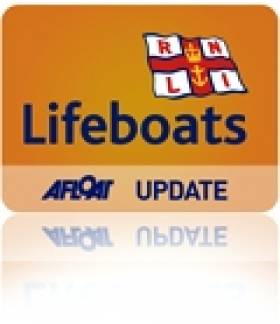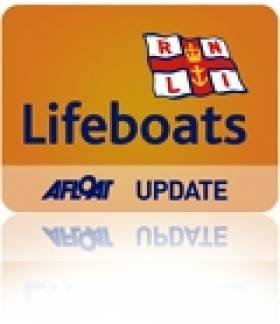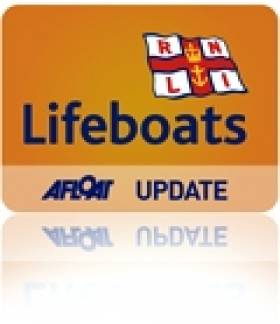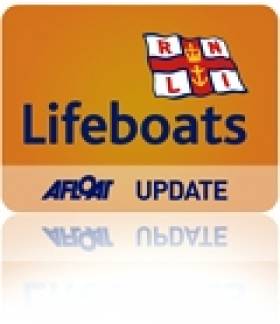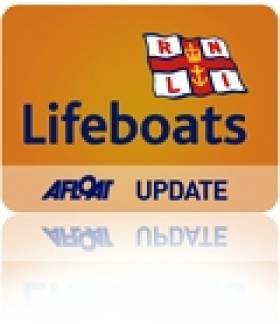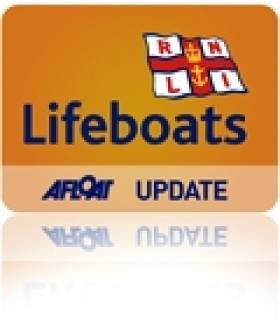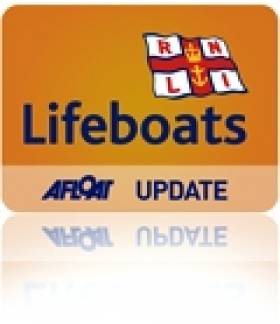Displaying items by tag: Donaghadee
#RNLI - Arklow RNLI’s volunteer lifeboat crew were alerted by pager at 6.44pm yesterday evening (14 June) to a call for help from a local fishing vessel in the station's second callout of the week, following the lifeboat's midweek rescue of a stricken sailboat.
The crew consisting of coxswain Ned Dillon, station mechanic Michael Fitzgerald, John Bermingham, Scotty Heaney, Keith Forde and Eddie McElheron launched the lifeboat Ger Tigchleaar and proceeded to the vessel, which had suffered machinery failure and was adrift outside the mouth of Arklow Harbour.
After locating the casualty vessel, the lifeboat crew established a tow line and proceeded back in to Arklow with the vessel alongside. All crew members aboard the casualty remained aboard during the service and all hands came ashore safely.
Speaking following the incident, Arklow RNLI volunteer lifeboat press officer Mark Corcoran said: "All people who take to the water whether for a living or for pleasure must always wear their lifejackets and should always have a means of raising the alarm."
Elsewhere, RNLI volunteers aboard Donaghadee's all-weather lifeboat Saxon sped to the rescue of a stricken vessel as darkness fell on Friday evening (12 June).
The 10-metre craft with a crew of one developed engine trouble on a passage to Westport in Co Mayo and was adrift in the busy sea lanes at the mouth of Belfast Lough.
The Donaghadee lifeboat launched at the request of the coastguard at 10.15pm and conducted a search in the gathering gloom one mile north of the Copeland Islands until the vessel was located.
In light sea conditions, a member of the RNLI crew boarded the vessel to assist with repairs and the lifeboat then escorted it to the safety of Bangor Marina. Saxon was back on station and stood down shortly after midnight.
Donaghadee RNLI coxswain Philip McNamara advised all boat owners "to conduct a thorough check of their engines, communications and safety equipment before putting to sea.
"If you encounter a problem, call for assistance at the earliest opportunity. We are ready to be of service and It is always better to be safe than sorry."
#beargryllslifeboat – TV adventurer, Bear Grylls, has given his support to a campaign to save Ireland's most famous lifeboat. His great grandfather, Sir Walter Smiles, was among 130 people who died in the Princess Victoria tragedy of 1953. The Royal National Lifeboat Institution's volunteer crew at Donaghadee in Northern Ireland, aboard the Sir Samuel Kelly lifeboat, risked their lives in monstrous seas to save 33 passengers. The lifeboat was also involved in saving yachtsmen during the Fastnet yacht race disaster in 1979.
Bear Grylls said: "I am delighted to express my support and extend my best wishes to the Sir Samuel Kelly Project.
"I do so out of respect for the 133 passengers who were lost in the Princess Victoria tragedy of 1953. The dead include my great grandfather Sir Walter Smiles at whose home in Donaghadee I spent many happy summer days as a boy.
"I do so also out of respect for the Royal National Lifeboat Institution and the volunteer crew of the Sir Samuel Kelly lifeboat who battled monstrous seas for 36 hours and risked their own lives to rescue 33 people from the ferry. To the crew of today's RNLI lifeboat based in Donaghadee, and the 234 RNLI lifeboat crews around the coasts of Britain and Ireland, I express my admiration at their courage and commitment.
"The restoration and preservation of the Sir Samuel Kelly lifeboat, and the construction of a heritage centre in Donaghadee to provide it with a permanent home, will create a fitting memorial to all those who were touched by the Princess Victoria tragedy. It will be a lasting reminder that we are all at the mercy of nature and of the need for preparedness and professionalism when saving lives at sea."
The SSK Project is a public appeal, initially to raise between £15,000 and £20,000, which will be used to build a temporary shelter for the lifeboat. The shelter has been designed by architects Fraser Bell and Michael Collins. This will allow it to dry out and the restoration job to be assessed. The project's next goal is to secure Lottery funding to build a permanent museum with the lifeboat as a centrepiece.
Project spokesman Ken Walsh, said: "We know Bear has a special place in his heart for Donaghadee. He tells us it is where he found his love of the sea and the wild. We are delighted to have his support and encouragement.
"The Sir Samuel Kelly is an important part of Ireland's maritime heritage and is on the UK's National Historic Ships register. Restored, it will be a lasting memorial to the people who were lost in the Princess Victoria and Fastnet tragedies. It will also be a fitting tribute to the bravery of the RNLI crews who daily risk their lives to save others. With public support we believe we can raise the £500,000 needed to build her a fitting home in a town where she was stationed for 25 years and is still cherished."
Expressions of interest and contributions are welcome at the project's new website here or on Facebook.
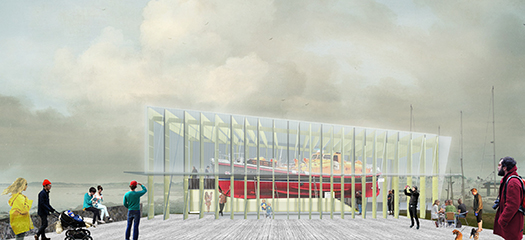
Artist's impression of the proposed temporary shelter
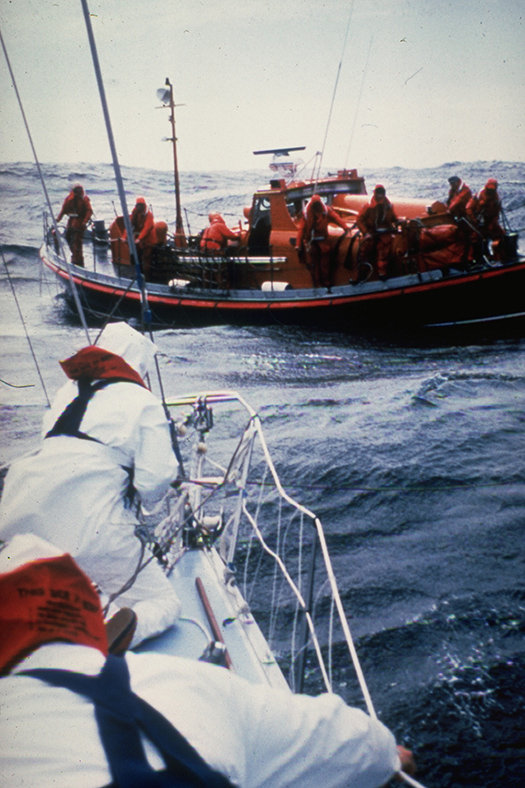
Action stations - The Sir Samuel Kelly during the Fastnet disaster. Picture courtesy of Ambrose Greenway and the RNLI

Bear Grylls
The Sir Samuel Kelly lifeboat was named after a Belfast coal importer and philanthropist who died in 1937. It was built by J Samuel White & Co at Cowes on the Isle of Wight in 1950. The Watson class lifeboat was stationed at Donaghadee from 1951 until 1976 then was part of the RNLI reserve fleet at Courtmacsherry, Co Cork, until retirement in 1979. An RNLI bravery medal and a British Empire Medal were awarded to the Kelly's coxswain Hugh Nelson for his role in saving 33 from the Princess Victoria in 1953. The lifeboat was purchased by the Ulster Folk and Transport Museum and passed to the project group in 1985.
Bear Grylls has become known around the world as one of the most recognized faces of survival and outdoor adventure. His journey to this acclaim started in the UK, where his late father taught him to climb and sail. Trained from a young age in martial arts, Bear went on to spend three years as a soldier in the British Special Forces, serving with 21 SAS. It was here that he perfected many of the skills that his fans all over the world enjoy watching him pit against mother-nature. His TV shows Man Vs Wild and Born Survivor became some of the most watched programmes on the planet with an estimated audience of 1.2 billion. He also hosts the hit adventure show Running Wild on NBC in America, as well as The Island with Bear Grylls on C4 and Mission Survive for ITV.
He is currently the youngest ever Chief Scout to the UK Scout Association and is an honorary Lt-Colonel to the Royal Marines Commandos. He has authored 15 books including the number one Bestseller: Mud, Sweat & Tears.
Women Wanted For Northern Ireland Lifeboat Crews
#Lifeboats - Donaghadee's lifeboat station is putting out a new call for volunteers - and women are particularly welcome, as UTV News reports.
The Ards Peninsula town, just outside of Belfast Lough, hosts one of Northern Ireland's nine RNLI lifeboat stations, which combined accounted for 281 people rescued in 2014.
But only 10% of the North's lifeboat volunteers are women, prompting a renewed appeal by Donaghadee coxswain John Ashwood - who hastens to add that the RNLI is an equal opportunities recruiter.
“At the end of the day, here in Donaghadee, the whole ethos is getting the right person to do the job whether male of female," he says.
UTV News has more on the story HERE.
Lucky Escape For Three Men In A Boat Thanks To Donaghadee RNLI
#RNLI - Three young men had a lucky escape on Sunday evening (3 August) when their small boat began sinking on a pleasure trip from Ballywalter to Donaghadee.
The Irish Coast Guard was alerted to the emergency by one of the boat’s crew members using his mobile phone. He was unsure of his position but reported that the party was somewhere between the Copeland Islands, Bangor and Donaghadee.
Heading in the direction of Belfast Lough, Donaghadee RNLI’s all-weather lifeboat Saxon spotted the vessel – a small orange and white speedboat – and within a few minutes was on the scene.
The three casualties were taken aboard and checked for injury or illness. One had fallen into the water and was beginning to suffer from the effects of the cold.
The speedboat was taken under tow to Donaghadee Harbour. The survivors were brought to the boathouse where they were given hot drinks and after warming up they were collected by relatives.
“This could so easily have been a tragedy," Donaghadee RNLI coxswain Philip McNamara. "Even in calm conditions the sea is a dangerous place.
"All those who enjoy boating should ensure they have lifejackets and safety equipment before they set out. Always check the weather and ensure someone knows what you are doing and when you expect to return.”
In other lifeboat news, Courtown RNLI launched yesterday afternoon (4 August) to a call from two people on a speedboat who were unable to get their boat started and were drifting onto the beach at Ardamine.
After some manoeuvrings the lifeboat crew managed to tow the 19ft speedboat off the sand and back to the harbour in Courtown, were it was discovered that the fan belt had broken in the engine.
Lough Derg Lifeboat Investigates Drifting Dinghy
#RNLI - Lough Derg RNLI's lifeboat launched on Sunday 1 June to investigate reports of a dinghy adrift off Parker's Point on the Clare shore.
At 6.35pm Valentia Coast Guard requested Lough Derg RNLI to investigate reports of a dinghy adrift in open water in the direction of Meelik Bay.
The lifeboat launched three minutes later with helm Eleanor Hooker and crew Ger Egan and Liam Knight on board. Winds were south-westerly Force 3 to 4 and visibility was fair to good, with frequent line squalls.
Coastguard staff gave the lifeboat crew the co-ordinates at which the dinghy was seen, and a description of the boat. The lifeboat reached the location at 7pm and its crew calculated the drift of the dinghy given its size and the wind direction.
On the shore where the dinghy would have landed, a remote location, the RNLI crew could detect an oar being raised and lowered above the reeds, and went to investigate.
It was soon discovered that a local family of five a fishing trip had seen the dinghy and had towed it to shore, where they safely moored it up. The dinghy did not have an engine and there was no evidence of it having been occupied.
Reporting these findings to Valentia Coast Guard, the lifeboat was stood down and returned to station. Later, the owner of the dinghy made contact with Valentia explaining that his tender had broken free from his cruiser in rough weather earlier in the day.
Lough Derg RNLI deputy launching authority Pat Garland said: "A small craft adrift in the middle of the lake has implications other than the boat might have slipped its moorings, which, thankfully, is the case today."
He commended the boat users on the lake for their "diligence on their watch and for reporting the dinghy".
In another false alarm, Donaghadee’s all-weather Lifeboat Saxon launched around 8.00pm on Saturday 31 May after reports of an object in the water off the coast of the Copeland Islands in Co Down.
A witness described what appeared to be people in the water, and the lifeboat was on scene within 15 minutes - to find nothing more than a bunch of helium-filled party balloons that had come down in the sea.
Lifeboat coxswain Philip McNamara said: "While this was a preventative operation, the lifeboat volunteers prefer to attend at an early stage to avoid any risk to life. An object in the water can be a danger to shipping.”
The same day saw Courtown RNLI's volunteer lifeboat launch to the aid of a small angling boat that had suffered engine failure.
However, the launch was delayed by a car and boat trailer that had been parked across the launching winch area for the lifeboat.
Thankfully the lifeboat – crewed by Glen Deacon, Fergus Slevin and Robert Ireton Jr – was launched by other means and was quickly alongside the casualty, towing the boat back into harbour.
Courtown lifeboat operations Manager Sam Kennedy said: "We urge people not to park across the launching area or to block up the slipway in Courtown. We were lucky that this was not a more serious incident and the delay didn't cause loss of life."
Donaghadee Lifeboat Rescues Crew On Becalmed Yacht
#RNLI - Donaghadee RNLI rescued a yacht and crew when they became becalmed in the Irish Sea on Good Friday last.
The Co Down coastal town's all-weather lifeboat Saxon was at sea within 10 minutes of the request for assistance from the coastguard at 3.47pm.
At the scene, close to South Rock south of Portavogie, a tow line was established to the 31-foot vessel that had suffered engine failure and was unable to make headway by sail in the calm conditions.
The yacht was towed to Donaghadee in an operation lasting more than two hours. The lifeboat was then stood down at 6.05pm.
Lifeboat coxswain Philip McNamara said: "While this was a preventative operation, the lifeboat volunteers prefer to attend at an early stage to avoid any risk to life should weather conditions change or the light should fade.”
Donaghadee Lifeboat Rescues PWC Rider From Rocks
#RNLI - The volunteer lifeboat crew from Donaghadee RNLI rescued a personal watercraft (PWC) enthusiast from rocks near Millisle in Co Down on Saturday evening (12 April).
A member of the public reported the craft in difficulty south of Millisle lagoon and the RNLI responded to a request for assistance from the coastguard.
The Donaghadee all-weather lifeboat Saxon was at sea within 10 minutes at 7.20pm.
At the scene, the lifeboat crew deployed a small inflatable off the lifeboat, with two crew members aboard, and the PWC with one person aboard was helped off the rocks.
The craft was then towed to a slipway and the lifeboat stood down at 8.20pm.
Donaghadee RNLI lifeboat operations manager Alan Couser said: "If you are planning to visit the coast over the Easter holidays, make sure you check the sea-worthiness of all small craft and that safety equipment is working properly."
Fisherman Rescued By RNLI Crew Meets His Rescuers - And Owes His Life To Lifejacket Initiative
#RNLI - A fisherman whose boat sank in minutes has thanked several organisations who implemented and trained him on using a lifejacket for saving his life.
Samuel Cully, a fisherman from Portavogie, was in the water for 45 minutes after his vessel sank on Wednesday 18 September, off the coast of Co Down. Weather conditions at the time were rough seas with Force 5 to 6 winds blowing.
RNLI lifeboats from Portaferry and Donaghadee were launched within minutes of a May Day being received by the Belfast Coastguard, along with the Irish Coast Guard helicopter Rescue 116.
Recently Cully was reunited with the volunteer crew at Portaferry who rescued him.
Just weeks earlier, Cully had been provided with a personal flotation device in a grant-aided scheme run by the Fishermen’s Mission with funding and support from Seafish, the Department for Agriculture and Rural Development through the European Fisheries Fund, the Northern Ireland Fish Producers Organisation, RNLI, the Maritime Coastguard Agency and supermarket Asda.
The project aims to ensure that fishermen will receive a grant-aided PFD and the training required to ensure its proper use.
Frankie Horn, RNLI fishing safety manager for the UK and Ireland, said: "It’s great that Samuel is safe, and back with his family. We want fishermen to see the benefits of wearing a personal flotation device or lifejacket and for them to wear it voluntarily.
"This will be an ongoing process for us, talking to fishermen and working with the manufacturers to ensure that the PFDs provided are the best possible design for the fishing industry."
With the funding and logistics generously covered by other agencies, the RNLI was involved in leading the safety training session – an act that Cully is immensely grateful for.
"I was only able to swim five or ten metres or so, and even then the wind and swell were washing me away from the shore," he recalled. "The boat went down so quickly, and I was so relieved to find the lifejacket doing exactly what I was told it would do. I cannot thank all those organisations involved enough."
In more recent news, Donaghadee and Portaferry RNLI launched yesterday (Tuesday 8 October) to go to the aid of a man fishing off rocks who became stranded by the tide.
Belfast Coastguard had received a call from a member of the general public just after 10.20am alerting them of the emergency.
On arriving on the scene, Donaghadee's all-weather lifeboat crew found their colleagues from Portaferry RNLI's inshore lifeboat were taking the man off the rocks and returning him safely into Portavogie harbour.
Donaghadee RNLI Rescues Man In Boat Breakdown
#RNLI - Donaghadee RNLI has rescued a man after his boat got into difficulty off the Co Down coast.
- In good weather conditions, the volunteer crew launched the all-weather lifeboat at 3.07pm yesterday (Wednesday 26 June) to go to the aid of a casualty off Mew Island.
It followed a request by Belfast Coastguard which had received a call from the owner of the 4m boat to say his vessel had broken down and had starter motor problems.
The lifeboat located the boat north of Mew Island, where it was taken safely under tow by the crew and brought to Donaghadee Harbour.
Earlier in the week, a group of young people from the RNLI Storm Force visited the Donaghadee lifeboat station for a guided tour that emphasised the importance of safety on the water.
The children and their parents were given a warm welcome by coxswain Phillip McNamara and members of the station, who explained the work they do when they respond to emergencies - including getting into their lifeboat gear and jackets in a hurry!
Koda The Husky Rescued By Quick-Thinking RNLI Crew
#RNLI - Two volunteer crew members from Kinsale RNLI came to the rescue of a husky dog who had a dramatic fall off a cliff near the Co Cork village recently.
Koda, a pedigree husky, was inspecting the coastline around Sandycove when she got too close to the edge and slipped over the 30ft cliff.
The dog landed in water with a strong current that swept her out to sea despite her desperate struggles to reach the shore. She managed to get herself back on a ledge by which time the alarm was raised and volunteer lifeboat crew were on their way.
A jagged reef also meant that Kinsale RNLI’s inshore lifeboat couldn't get close enough to help drag the struggling dog from the water.
However, Kinsale RNLI volunteers Nick Searls and Ian Fitzgerald were at the scene within minutes, and realised the danger facing the terrified dog.
Searles dived into the sea and swam over 60 metres to reach the animal. He managed to attach a harness and was able to swim slowly back to shore, dragging the weakened Koda with him. He was then assisted by safety line out of the sea by Fitzgerald.
Koda was immediately taken to a Kinsale vet, who confirmed that despite being exhausted and shocked by her ordeal, the dog was none the worse for wear.
In other news, Donaghadee RNLI assisted two men on board a yacht which got into difficulty off the Co Down coast yesterday morning (Tuesday 7 May).
The volunteer lifeboat crew was requested to launch at 9.50am by Bangor Coastguard to go to the aid of a yacht which had ran aground.
The 30ft yacht with two people on board had gone aground on rocks at the entrance to Donaghadee Marina.
With the help of another vessel, the lifeboat crew was quickly able to get a tow line to the yacht and pull it off the rocks.
The yacht, which had sustained some damage to its rudder, was able to make its way safely into the marina.


























